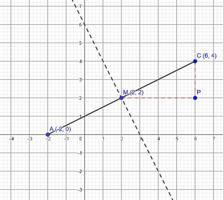Kulla_9289
Junior Member
- Joined
- Apr 18, 2022
- Messages
- 214
ABCD is a square. A is the point (-2, 0) and C is the point (6, 4). AC and BD are diagonals of the square, which intersects at M. Find the coordinates at M.
My attempt:
M will be the midpoint of AC because AC and BD are perpendicular to each other. So, M is (2, 2). However, I am no so sure on how to find B and D.
My attempt:
M will be the midpoint of AC because AC and BD are perpendicular to each other. So, M is (2, 2). However, I am no so sure on how to find B and D.

